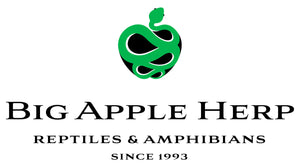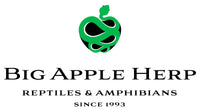Care Sheet for Sand Boa
Sand Boas are a popular choice among reptile enthusiasts and new reptile owners due to their even-temper, relatively small size and longevity. Baby Sand Boas are approximately 6” to 8” with adults reaching 24” to 36”. Males generally are slightly smaller than females. With proper care, Sand Boas can live more than 15 years. At Big Apple Pet Supply, we carry only Captive Bred Sand Boas to maintain strict quality control.
Housing
Sand Boas can be set up in an enclosure as small as 10 gallons (20" x 10" x 12"H), and can remain in a small enclosure for the duration of their life. A secure screen top is absolutely critical to keep your snake from escaping the enclosure. You can house two females or a male and female together, but not two males. If you house more than one Sand Boa together, always feed each one individually.
Substrate
A mixture of Zoo Med Aspen Snake Bedding and Zoo Med Repti Sand makes a good bedding for Sand Boas. Make sure your substrate is at least 2” deep to allow for burrowing.
Heating
Sand Boas require all day temperatures of 80° to 85° Fahrenheit. A hot spot of 90° to 95° F should be provided at one end. The best way to heat your Sand Boa’s enclosure is with a combination of Intellitemp Heat Mat and Big Apple Black Heat Infrared Ceramic Heat Emitter. The heat mat and ceramic heat emitter should be on one side while the other side should not have any heat source. We recommend controlling the ceramic emitter with a thermostat, such as the BAH-500 or BAH-1000DC, and monitoring the temperatures with a thermometer.
Lighting
Sand Boas, like all snakes, do not require a light or UV bulb. If you choose to add a bulb for more light in your cage, make sure you maintain proper heat levels. Do not allow temperatures over 95° F as this could be detrimental to your snake's health.
Shelter
Like all reptiles and amphibians, Sand Boas shed their entire skin all at once. Babies shed more often than adults because as babies they outgrow their skin faster. You'll note shedding time when your snake's eyes turn a shade of blue and become cloudy. At that time, begin misting with water from a spray bottle to ensure proper humidity and facilitate shedding. Outside of the shed cycle, Sand Boas should have minimal humidity.
You need to check your snake after it has shed to make sure it was able to peel all the skin off, especially around the eyes. If unshed skin is not removed promptly serious health issues can form. If your Sand Boa has retained skin after shedding you can place the snake in a plastic container lined with warm, wet paper towels with the container lid on or soak the snake in warm water. Let the snake stay in the container or warm water for approximately 30 minutes. The high humidity in the container or using the soaking method should loosen the skin enough to allow you to remove it easily with a pair of tweezers. If the skin has not loosened enough, reheat the paper towels with warm water and provide another 30 minute session. NEVER use hot water as this can burn your snake.
Water
It is essential that you provide your Sand Boa with a large, heavy water bowl that cannot be easily tipped over. The bowl should be large enough that the snake can soak its entire body in but not so big that it might have a difficult time getting in or out of the bowl. Place the water dish on the cool side of the cage so that it does not evaporate quickly.
Food
Sand Boas will eat mice of varying sizes dependent upon the girth of the snake. Even with frozen/thawed prey, Sand Boas will sometimes drag the prey under the sand to “suffocate” the animal prior to eating. You should not feed your snake anything bigger than the thickest part of its body. The prey item should leave a readily noticeable lump in the snake. This is fairly standard for all species of snakes. Hatchling snakes are typically fed every 5 days while adults are typically fed every 10 days. However, it should be noted that some hobbyists feed adult snakes once a week.
Feeding live or pre-killed is a question we are often asked. Opinions vary on this subject but we are emphatic that thawed frozen rodents are a much better option. First, feeding thawed rodents is easier and second it's substantially less expensive because you can purchase rats or mice in bulk and then store them in the freezer. More importantly, it is significantly safer for the snake. The bottom line is a thawed prey mouse or rat will never bite or chew on your snake in defense. We have seen nasty rodent bites inflicted on snakes when fed live rodents. We suggest you play it smart and go with feeding thawed prey items. At Big Apple Pet Supply, we carry a huge selection of frozen feeders that we deliver right to your door.
Vitamins
It is important to feed high quality rodents to your snake and it is always a good idea to coat the rodent with a bit of vitamin and calcium powders before feeding them. We carry a full line of quality reptile vitamins and calcium.
Cage Maintenance
Sand Boas require minimal maintenance as they usually excrete small amounts of semi-solid fluid which can be cleaned using one of our scoopers. The bedding should be completely thrown out and the entire cage (including all accessories) should be washed at least once every four to five months with Quat TB Pet Area Cleaner, Deodorizer & Stain Remover or a mild detergent. If using paper towels for bedding, change all paper towels at least once a week.
Hibernation
Hibernation is not natural for Sand Boas so make sure you heat your snake’s enclosure throughout the winter so that they continue to eat, drink and be active. A general reduction in feeding behavior is normal during winter months due to temperature fluctuations in your house. As long as they keep fairly consistent weight it is generally not an issue and normal feeding typically resume in the spring.

